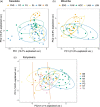Chimpanzee pant-hoots encode individual information more reliably than group differences
- PMID: 36093564
- PMCID: PMC9786991
- DOI: 10.1002/ajp.23430
Chimpanzee pant-hoots encode individual information more reliably than group differences
Abstract
Vocal learning, the ability to modify the acoustic structure of vocalizations based on social experience, is a fundamental feature of speech in humans (Homo sapiens). While vocal learning is common in taxa such as songbirds and whales, the vocal learning capacities of nonhuman primates appear more limited. Intriguingly, evidence for vocal learning has been reported in chimpanzees (Pan troglodytes), for example, in the form of regional variation ("dialects") in the "pant-hoot" calls. This suggests that some capacity for vocal learning may be an ancient feature of the Pan-Homo clade. Nonetheless, reported differences have been subtle, with intercommunity variation representing only a small portion of the total acoustic variation. To gain further insights into the extent of regional variation in chimpanzee vocalizations, we performed an analysis of pant-hoots from chimpanzees in the neighboring Kasekela and Mitumba communities at Gombe National Park, Tanzania, and the geographically distant Kanyawara community at Kibale National Park, Uganda. We did not find any statistically significant differences between the neighboring communities at Gombe or among geographically distant communities. Furthermore, we found differences among individuals in all communities. Hence, the variation in chimpanzee pant-hoots reflected individual differences, rather than group differences. Thus, we did not find evidence of dialects in this population, suggesting that extensive vocal learning emerged only after the lineages of Homo and Pan diverged.
Keywords: chimpanzee; dialects; pant-hoot; vocal learning.
© 2022 The Authors. American Journal of Primatology published by Wiley Periodicals LLC.
Conflict of interest statement
The authors declare no conflict of interest.
Figures





Similar articles
-
Phrase structure of wild chimpanzee pant hoots: Patterns of production and interpopulation variability.Am J Primatol. 1996;39(3):159-178. doi: 10.1002/(SICI)1098-2345(1996)39:3<159::AID-AJP2>3.0.CO;2-Y. Am J Primatol. 1996. PMID: 31918501
-
Nonlinear acoustics in pant hoots of common chimpanzees (Pan troglodytes): frequency jumps, subharmonics, biphonation, and deterministic chaos.Am J Primatol. 2004 Nov;64(3):277-91. doi: 10.1002/ajp.20078. Am J Primatol. 2004. PMID: 15538766
-
Re-emergence of the leaf clip gesture during an alpha takeover affects variation in male chimpanzee loud calls.PeerJ. 2018 Jun 28;6:e5079. doi: 10.7717/peerj.5079. eCollection 2018. PeerJ. 2018. PMID: 29967740 Free PMC article.
-
Towards a new taxonomy of primate vocal production learning.Philos Trans R Soc Lond B Biol Sci. 2020 Jan 6;375(1789):20190045. doi: 10.1098/rstb.2019.0045. Epub 2019 Nov 18. Philos Trans R Soc Lond B Biol Sci. 2020. PMID: 31735147 Free PMC article. Review.
-
No evidence of short-term exchange of meat for sex among chimpanzees.J Hum Evol. 2010 Jul;59(1):44-53. doi: 10.1016/j.jhevol.2010.02.006. Epub 2010 May 21. J Hum Evol. 2010. PMID: 20493515 Review.
Cited by
-
Maternal effects on the development of vocal communication in wild chimpanzees.iScience. 2022 Sep 19;25(10):105152. doi: 10.1016/j.isci.2022.105152. eCollection 2022 Oct 21. iScience. 2022. PMID: 36238895 Free PMC article.
-
Overcoming bias in the comparison of human language and animal communication.Proc Natl Acad Sci U S A. 2023 Nov 21;120(47):e2218799120. doi: 10.1073/pnas.2218799120. Epub 2023 Nov 13. Proc Natl Acad Sci U S A. 2023. PMID: 37956297 Free PMC article.
-
Context-dependent rhythmicity in chimpanzee displays.Proc Biol Sci. 2024 Dec;291(2036):20242200. doi: 10.1098/rspb.2024.2200. Epub 2024 Dec 4. Proc Biol Sci. 2024. PMID: 39626754 Free PMC article.
-
What we know and don't know about great ape cultural communication in the wild.Am J Primatol. 2025 Jan;87(1):e23560. doi: 10.1002/ajp.23560. Epub 2023 Oct 12. Am J Primatol. 2025. PMID: 37828822 Free PMC article. Review.
-
Innovative multi-material tool use in the pant-hoot display of a chimpanzee.Sci Rep. 2022 Nov 29;12(1):20605. doi: 10.1038/s41598-022-24770-w. Sci Rep. 2022. PMID: 36446876 Free PMC article.
References
-
- Arcadi, A. C. , & Wallauer, W. (2013). They wallop like they gallop: Audiovisual analysis reveals the influence of gait on buttress drumming by wild chimpanzees (Pan troglodytes). International Journal of Primatology, 34(1), 194–215.
-
- Aureli, F. , Schaffner, C. M. , Boesch, C. , Bearder, S. K. , Call, J. , Chapman, C. A. , Connor, R. , Fiore, A. D. , Dunbar, R. I. , & Henzi, S. P. (2008). Fission‐fusion dynamics: New research frameworks. Current Anthropology, 49(4), 627–654.
-
- Bartlett, P. , & Slater, P. J. B. (1999). The effect of new recruits on the flock specific call of budgerigars (Melopsittacus undulatus). Ethology Ecology & Evolution, 11(2), 139–147. 10.1080/08927014.1999.9522832 - DOI
Publication types
MeSH terms
LinkOut - more resources
Full Text Sources

